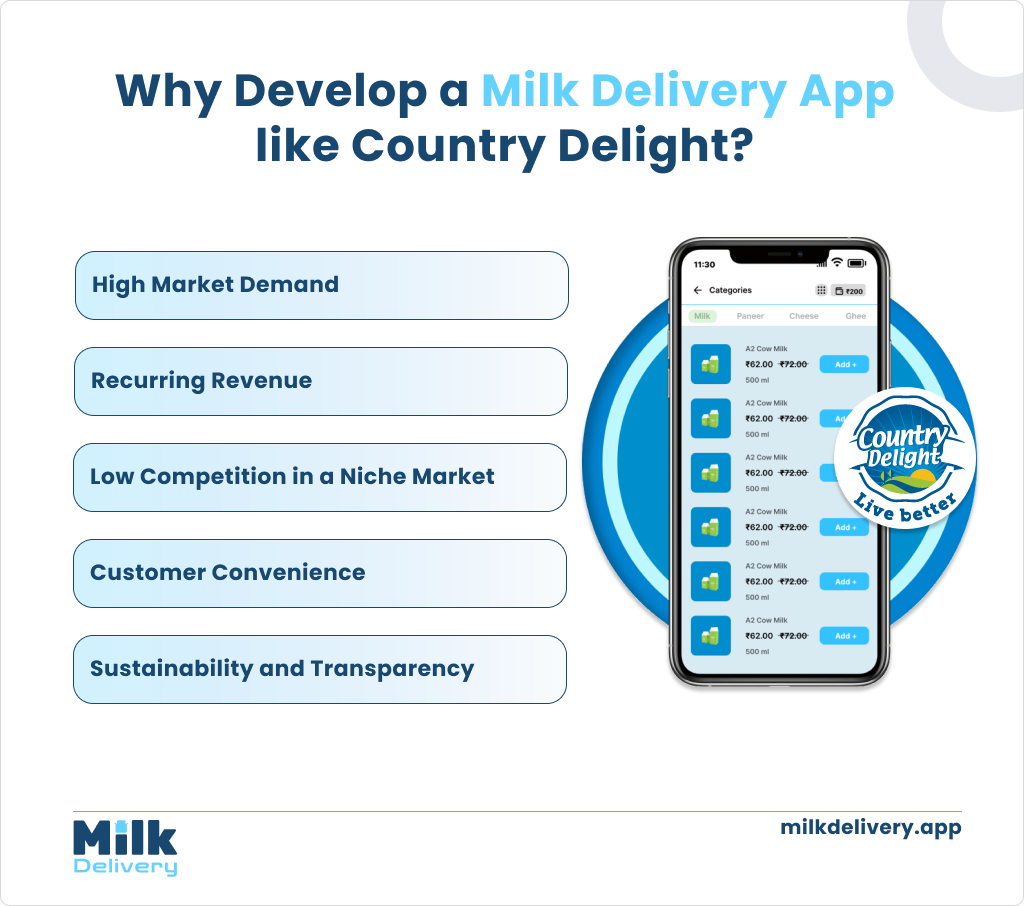The dairy industry has undergone a significant transformation with the integration of technology, bringing milk delivery apps to the forefront of this change. Platforms like Country Delight have raised the bar by delivering fresh milk and other dairy products directly to consumers. Their success highlights the growing demand for subscription-based milk delivery solutions, making this a lucrative opportunity in 2025.
Founded in 2015 by Nitin Kaushal and Chakradhar Gade, Country Delight set out to revolutionize the way milk and dairy products are sourced and delivered. The company’s mission is to provide unadulterated, farm-fresh products directly to customers’ doorsteps through a Direct-to-Consumer (D2C) model. By sourcing directly from farmers, they ensure freshness and superior quality.
This guide will walk you through the essential steps for developing a milk delivery app, covering features, costs, business models, and key considerations. We’ll take you through the entire process of milk delivery app development. Whether you’re an aspiring entrepreneur or an established business owner, this resource is designed to educate, inspire, and guide you.
What is Country Delight?
Country Delight is a Direct-to-Consumer (D2C) platform delivering fresh dairy and farm products. Its delivery model revolves around sourcing directly from farmers, ensuring freshness and quality. The app leverages technology for order management, subscriptions, and customer engagement, setting a benchmark in the milk delivery solution space.
Milk Delivery Apps and Their Types
Milk delivery apps are categorized based on their functionality, target audience, and services offered. Understanding these types can help you determine the best approach for your business.
Subscription-Based Apps
These apps allow users to subscribe to daily or weekly milk deliveries. Customers can manage orders, pause deliveries, or change quantities as needed. An example is Country Delight.
Marketplace Apps
These apps connect multiple dairy providers with customers, allowing users to choose from various brands and products. An example is BigBasket.
Single-Vendor Apps
These apps, designed for individual dairy farms or brands, focus on direct customer engagement and provide a personalized experience. Example: Domino’s
Multi-Vendor Apps
These apps allow multiple vendors to list their products, giving customers a broader selection. This model is ideal for large-scale businesses. Example: Zomato
Hybrid Apps
Combining features of subscription-based and marketplace models, hybrid apps offer flexibility and convenience to users. Example: Amazon
Key Pillars of Country Delight’s Business Model
1. Direct Farm-to-Consumer Supply Chain
Country Delight bypasses traditional supply chain intermediaries to ensure superior product quality. By sourcing directly from farmers, the company minimizes delays and ensures freshness. This approach benefits both farmers, who receive better compensation, and consumers, who enjoy farm-fresh products.
2. Technology-Driven Operations
From procurement to delivery, technology is the backbone of Country Delight’s business model:
- Quality Control: AI and IoT-based tools monitor the quality of milk, fruits, and vegetables at every stage.
- Subscription Model: The mobile app allows customers to set daily or weekly delivery schedules, making the process seamless and predictable.
- Traceability: Customers can track product origins, offering transparency and building trust.
3. Focus on Freshness and Quality
Unlike mass-market products, Country Delight emphasizes minimal processing. For instance, their milk is free from adulteration and undergoes rigorous quality checks, reaching consumers within 24–36 hours of milking.
4. Hyper-Local Delivery Network
To ensure timely delivery, Country Delight employs a hyper-local delivery model. This not only reduces transportation time but also ensures that products retain their freshness when they reach the consumer.
5. Customer-Centric Approach
Country Delight engages directly with customers through its mobile app, offering:
Flexible subscription plans.
Feedback options to improve product quality.
Loyalty rewards for repeat customers.
Revenue Streams
1. Subscription Model
A significant portion of Country Delight’s revenue comes from its subscription-based offerings. Customers can choose daily or customized delivery plans, ensuring consistent sales.
2. Premium Product Range
Country Delight offers a range of premium, organic, and specialty products, catering to health-conscious and affluent customers willing to pay a premium for quality.
3. In-App Sales
The Country Delight app serves as a marketplace for other essential grocery items, including spices, oils, and snacks, creating additional revenue streams.
Why Develop a Milk Delivery App like Country Delight?

The success of Country Delight highlights the untapped potential of the milk delivery business. Here’s why you should consider developing a similar app:
1. High Market Demand
Milk is a daily necessity, and delivering fresh, high-quality milk directly to customers ensures a steady demand.
2. Recurring Revenue
The subscription model ensures consistent cash flow and customer retention.
3. Low Competition in a Niche Market
While food delivery apps dominate the market, specialized milk delivery solutions remain a growing niche.
4. Customer Convenience
A dedicated app simplifies the process of ordering fresh milk and other essentials, creating a loyal customer base.
5. Sustainability and Transparency
Apps like Country Delight focus on eco-friendly packaging and farm-to-home transparency, which resonate with modern consumers.
Step-by-Step Guide to Milk Delivery App Development
Building a milk delivery app may seem complex, but breaking it into manageable steps simplifies the process. Here’s how to get started:
1. Understand the Market
Conduct in-depth research to identify customer needs, pain points, and current market trends. Study competitors like Country Delight and Milk Basket to analyze their strategies and features. Use these insights to design a solution that meets customer demands effectively.
2. Define Your USP (Unique Selling Proposition)
Your USP sets your app apart from competitors. Focus on what makes your app unique—whether it’s delivering organic milk, eco-friendly packaging, or subscription flexibility. Align your USP with the values and preferences of your target audience.
3. Plan Essential Features
Incorporate user-friendly and advanced features that enhance customer experience and operational efficiency. Key features include:
- Real-Time Order Tracking: Allow customers to track deliveries live.
- Order Customization: Provide options for quantity, timing, or product preferences.
- Transparent Refund Policies: Build trust with clear return and refund guidelines.
- Inventory Management: Streamline stock tracking to avoid shortages or excess.
- In-App Communication: Enable seamless interactions between customers, drivers, and support.
4. Design the App’s Interface
Create an intuitive, visually appealing interface that reflects your brand. Focus on responsive designs compatible with multiple devices, and ensure navigation buttons are strategically placed for ease of use.
5. Develop the Backend
Build a robust backend to handle order processing, payments, and secure customer data. Choose scalable technology to support future growth and increased traffic.
6. Choose the Right Tech Stack
Select technologies that ensure reliability and scalability:
- Frontend: HTML, CSS, JavaScript
- Mobile Platforms: Android (Java/Kotlin), iOS (Swift)
- Backend: Node.js, Django
- Databases: MySQL, PostgreSQL
- Cloud Services: AWS, Google Cloud
- Additional Features: GPS tracking, secure payment gateways, real-time analytics
7. Testing and Quality Assurance (QA)
Thoroughly test the app to ensure smooth functionality, security, and usability. Conduct functional testing and beta testing to identify bugs or areas for improvement. Optimize the app based on user feedback.
8. Launch and Deployment
Begin with a soft launch to gather real-world data and feedback. Use this information to refine your app further. Optimize app store listings with relevant keywords, offer launch promotions, and collaborate with local vendors to establish credibility.
How Much Does It Cost to Build a Milk Delivery App?
The cost of developing a milk delivery app can vary significantly depending on factors like the app’s complexity, features, and the location of your development team. Here’s an overview of the potential costs:
- Basic App: $15,000 – $25,000
A basic app with essential features like user registration, order management, payment integration, and real-time tracking. - Advanced App with AI Features: $30,000 – $50,000
Apps with advanced features such as AI for personalized recommendations, route optimization, or predictive analytics. - White-Label Solution: $10,000 – $20,000
A pre-built, customizable solution with the ability to rebrand and offer milk delivery services quickly.
The total cost to build a milk delivery app could exceed $50,000 depending on the features, complexity, and resources required. If this budget is beyond your reach, consider using MilkDelivery.app SaaS-based milk delivery software, which starts at just $49/month. It’s a pre-built, customizable, and affordable solution to help you launch your milk delivery service without the high upfront costs.
How to Start a Milk Delivery Business in India
Starting a milk delivery business in India might seem challenging, but with the right approach, it can be a highly rewarding endeavor. At MilkDelivery.app, we’re here to guide you through every step of the process. To help you get started, here are some actionable tips to establish your very own milk delivery business in India.
1) Conduct In-depth Research and Planning
Begin with comprehensive market research. Study the demand for milk and dairy products, evaluate supply chain dynamics, analyze competitors, and identify potential challenges. A SWOT analysis can help you pinpoint your business’s Strengths, Weaknesses, Opportunities, and Threats.
Understanding these factors will help you design a robust business plan tailored to your target market’s needs and preferences.
2) Comply with Legal and Regulatory Requirements
Ensure you’re well-informed about all legal formalities required to register and operate your milk delivery business. This includes acquiring the necessary licenses and certifications. Also, focus on adhering to data privacy regulations and food safety compliance to maintain customer trust and avoid legal complications.
3) Build a Reliable Supply Chain
Secure a steady supply of fresh milk and dairy products by partnering with trusted milk producers, dairies, or farmers. Establish efficient procurement and distribution centers to ensure smooth operations.
Additionally, consider collaborating with a fleet management service for handling deliveries. Alternatively, if you prefer to manage deliveries in-house, hire reliable drivers and invest in suitable delivery vehicles to maintain efficiency and quality.
4) Develop and Customize Your Milk Delivery App
Creating a milk delivery app is essential for streamlining the entire process—right from order placement to payment and delivery tracking. Look to successful models like Country Delight for inspiration, but don’t stop there.
Take it a step further by customizing your app’s features to enhance the user experience. Offer personalized features, such as tailored product recommendations, order scheduling, and seamless payment options. Customers value convenience and personalization, which can significantly boost retention and loyalty.
Why Choose MilkDelivery.app SaaS-based Milk Delivery Software?
Here are three compelling reasons to choose MilkDelivery.app for your milk delivery business!
1. It’s Pre-built
MilkDelivery.app software is ready to launch with just a few modifications, saving you time and effort in app development.
2. It’s Customizable
You can tailor every aspect of the app, from features and elements to buttons, styles, and layouts, ensuring it perfectly aligns with your business needs.
3. White labeling is Affordable!
Building a milk delivery app from scratch can be expensive and resource-intensive. MilkDelivery.app offers a cost-effective alternative with its white-label milk delivery software solution. You can start your milk delivery app journey for as low as $49/month!
But that’s not all. MilkDelivery.app platform includes exclusive features such as:
- User role management for smooth operations.
- A call center dashboard for efficient customer support.
- A custom domain to establish your brand identity.
- Vendor and driver settlements for hassle-free payment processes.
- Automatic driver allocation to optimize deliveries.
With these robust features, the MilkDelivery.app ensures you stay ahead of the competition and build a successful milk delivery business effortlessly!
Conclusion
Investing in a milk delivery app is one of the smartest decisions you can make when starting your milk delivery business. Throughout this guide, we’ve explored various aspects, including the types of milk delivery apps and the successful business models of platforms like Country Delight. These examples can serve as inspiration as you create your own milk delivery system.
We’ve also outlined the step-by-step process for developing a milk delivery app. While this process can be complex and time-consuming, there’s an easier solution available.
With MilkDelivery.app ready-to-use white-label milk delivery software, you can fast-track your business setup and focus on scaling your operations. Don’t just dream about starting your milk delivery business—take action today with MilkDelivery.app!

